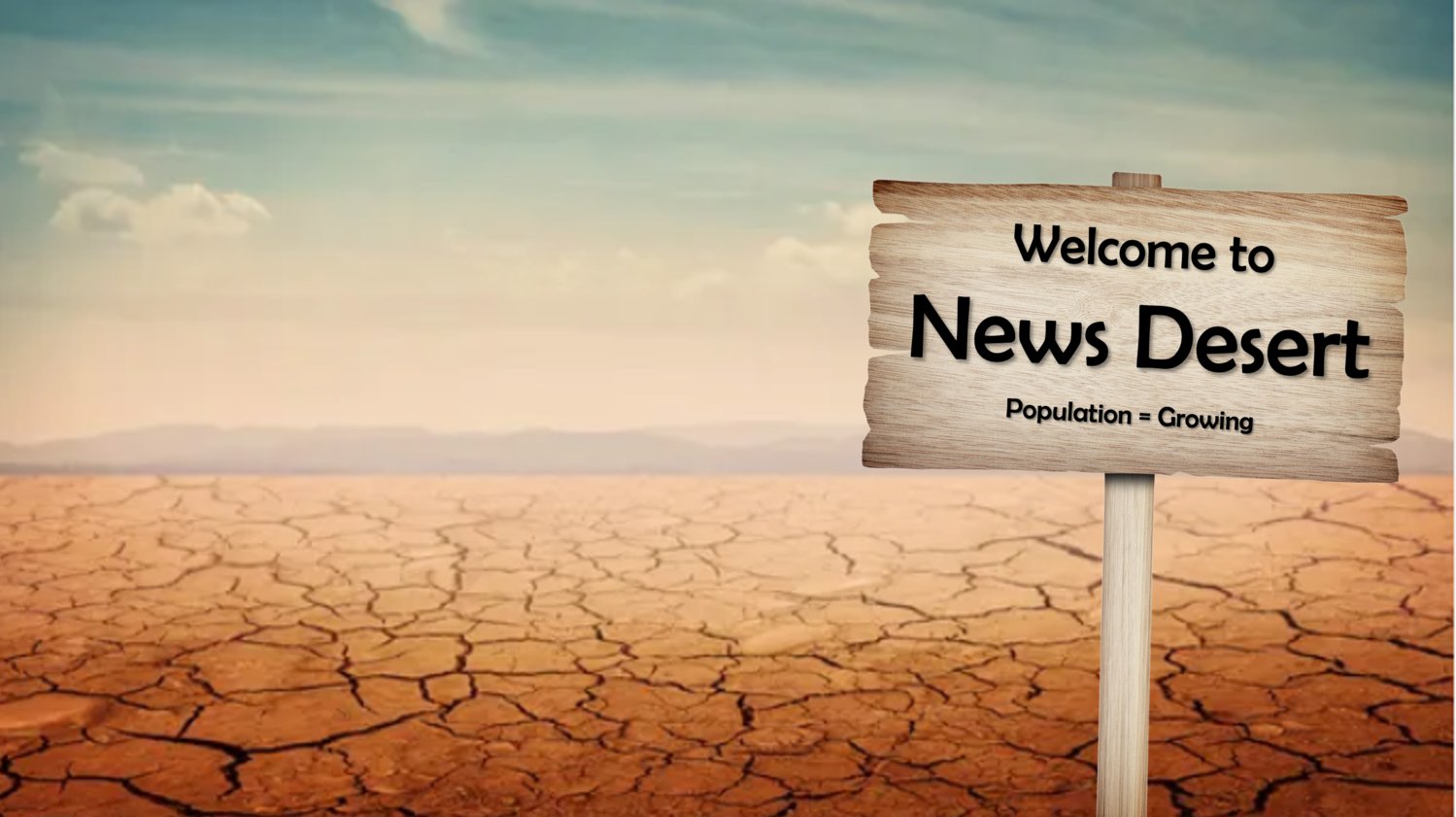
Newspapers were once at the heart of local communities — a vital way Americans found out about their neighbors and shared information. But now, as newspapers shut down across the country, the malignant spread of misinformation and disinformation take their place. A report from Medill called “The State of Local News 2022” finds that a fifth of the population lives in a news desert or a community at risk of becoming one.
“We can define news deserts as a place where residents in a community have very limited access to the sort of news and information that helps them make good everyday decisions, as well as good decisions that will affect the long-term quality of life of future generations,” said Penny Abernathy, the primary author of the report. Without access to credible information on issues such as education, health, the economy and the environment, people cannot determine what choices will positively impact them.

“I believe this is the most crucial issue facing the news industry and one of the most crucial issues facing our democracy, right now, is the availability of local news and information,” said the Senior Associate Dean of the Medill School, Tim Franklin, who oversaw the research report. Franklin is also the John M. Mutz Chair in Local News and director of the Local News Initiative at the school.
This report provides research that local newsgroups cannot conduct themselves. It also creates new tools, like the Medill Subscriber Engagement Index, which local news organizations can access for free. The tool tracks the behavior of local news readers and benchmarks how they are doing against their peers. The report also highlights how weeklies can be profitable.

“Where the news organization is located is very critical. If it is in an affluent or growing community, you’re going to have people who can pay for the news, or you’re going to have advertisers who want to reach those affluent people,” said Abernathy. She highlights two things to compensate for this situation — an entrepreneurial owner who can strategize the market correctly and enough support from the community to support for-profit or non-profit organizations. Although, the data shows more philanthropic money located in the communities of affluent people.
Investment entities have also flown into the market over the last decade and a half, which helped some dailies survive.
“While they had traditionally purchased stock, they decided they were going to run newspapers. And the problem with having institutional investors or investment entities run a newspaper is they have one purpose in life, and that is a return on shareholder, which is very, very different than the traditional newspaper chains we’ve had,” said Abernathy.

The level of commitment to civic journalism differs between traditional outlets and investors. This is illustrated in the data showing that roughly one-third of the newspapers were closed by the top 10 chains. The loss of reporters has been disproportionately carried out in newsrooms from the top 10 chains.
Franklin said these cuts are short-sighted, especially in a world with increased emphasis on reader revenue.
“You have to provide a product people are willing to pay for. You have to provide a product where people will turn over their credit cards to a news organization because there’s value there … if you’re not doing that — if you’re just a ghost newspaper that doesn’t have original, local reporting, pretty soon, people are going to stop giving their credit card information," said Franklin. He suggests that this issue is as old as capitalism, producing a product people are willing to pay for.
Abernathy highlights a point about offering the reader a product that people cannot get anywhere else or a product that affects the quality of life for that reader.
“If you’re always chasing clicks, you’re always chasing trying to get something out there fast, we’re not stopping to think what value we are actually providing the reader,” said Abernathy.
According to the Medill Subscriber Engagement Index, original, unique/enterprise reporting is what people are waiting to pay for.
The report ends with a call to action called Saving Local News, highlighting ongoing efforts to save local journalism. On the national level, legislation called the Local Journalism Sustainability Act would provide tax credits to hire journalists. Additionally, the bipartisan Journalism Competition and Preservation Act (JCPA), introduced last year, would exempt local news outlets from some antitrust laws so they could collectively bargain with technology companies for digital ad revenue.
Abernathy said she hopes the study is ongoing.
“We’re at a state in the industry where the change is happening so fast that we really need to periodically step in and say ‘What’s working, where is it working, and where are there still gaps,’” said Abernathy.
Victoria Holmes is a freelance journalist and writer based out of Dallas, Texas. Previously, Holmes worked as a TV news reporter and political podcast host at WNCT-TV in Greenville, North Carolina. Reach out to her on Twitter.
3 comments on this item Please log in to comment by clicking here
dbooth
Excellent industry assessment, especially Tim Franklin’s comments. Thank you E&P magazine for bringing us relevant information.
Thursday, August 25, 2022 Report this
howardowens
I continue to question Penny Abernathy’s methodology.
The headline graphic is the U.S. map showing the number of newspapers in each county. The implication can only be that a county with no newspaper is a “news desert” and those with one is hardly an oasis.
There is a strong premise in the report that only newspapers can deliver news even though it mentions the usual attention-getting digital efforts.
Using my geographic region for example: Orleans County is listed as no-newspaper even though a newspaper in our region has a reporter assigned to that county and there is a digital news site, Orleans Hub, that covers the county thoroughly. The implication that Orleans County is a news desert is just wrong.
To the south of my county, Wyoming County, it would seem like times are good – two newspapers. But these papers just cover singular communities and not the entire county. There is no online news publication there. Wyoming is much closer to a news desert than Orleans County.
In my home county, Abernathy lists one newspaper – presumably the Batavia Daily News (which covers the four-county region we call GLOW, Genesee, Livingston, Orleans, Wyoming). Understaffed like a lot of small papers these days but they still cover a lot of local news.
But Genesee County also has The Batavian, my business, and Video News Service, which is more of a freelance gig for a local videographer but she covers a lot of local news in the region.
Between the Daily News, The Batavian, and VNS, hardly anything goes uncovered. I’d wager that Genesee County is the most thoroughly covered small county in the nation. But you would never know it from Abernathy’s report.
And it’s important because dishonest people will distort inaccurate information for their own gain, as Nate McMurray did when he told Margaret Sullivan that he lost his congressional bid because the district he sought to represent was a news desert. Sullivan didn’t bother to fact-check his statement or Abernathy’s inaccurate report, and now McMurray’s disinformation is part of Sullivan’s book (which she doesn’t seem to care about).
It would be nice if Abernathy would drag herself out of the print-era mindset and be more thorough and inclusive in her report.
Howard Owens
Publisher, The Batavian (est. 2008)
Thursday, August 25, 2022 Report this
enigma58
The solution to a local news desert is the same as it has ever been...go to press. The market for readers and advertisers is as strong as it has ever been, and the cost of publishing has never been lower...still only about one penny per printed page. The demise of local newspapers is neither inescapable nor irreversible. It is, rather, wholly the inevitable product of publisher greed and professional indifference.
Thursday, August 25, 2022 Report this